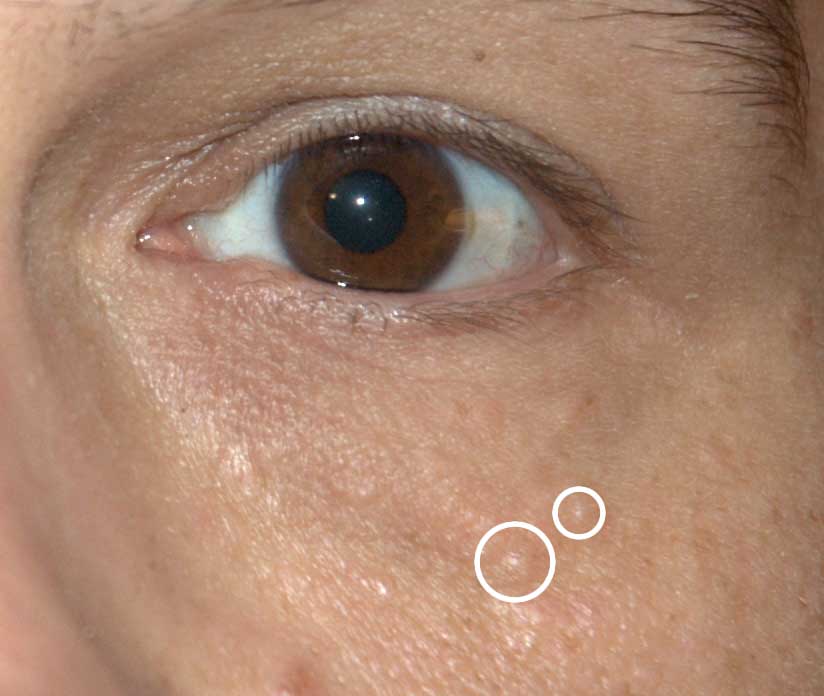What are Syringomas(汗管瘤)? - Explained by Dr. Yeung Ho Hong(楊浩康)
Syringomas highlighted by white circles. Photo by Mark A. Taff. See www.MarkTaff.com

What are Syringomas? - Explained by Dr. Yeung Ho Hong
Syringomas are benign sweat duct tumors, typically harmless, presenting as yellow or skin-colored, round, and firm nodules with a diameter generally ranging from 1 to 3 millimeters. These nodules often appear in clusters on the eyelids but may also occur on the face, armpits, upper chest, umbilicus, or vulva. Although syringomas do not cause pain or significant discomfort, their impact on appearance can lead to psychological distress for patients concerned about their looks.
The exact cause of syringomas is not fully understood, but they are generally believed to be related to the abnormal proliferation of sweat duct cells. These tumors primarily consist of epithelial cells within the sweat ducts, forming tiny masses in the skin tissue when normal differentiation regulation is disrupted. Due to their slow growth, syringomas often accumulate gradually over years and may go unnoticed, frequently being discovered incidentally during routine skin examinations.
Notably, apart from typical syringomas, there is a rare condition known as eruptive syringomas. In this case, patients may suddenly develop a large number of syringomas on the chest or lower abdomen within a short period, forming densely distributed skin lesions. Though uncommon, this condition significantly affects appearance and may require more proactive treatment measures to address.
Clinically, syringomas can sometimes resemble other skin conditions in appearance, such as Xanthelasma, Trichoepitheliomas, or Basal cell skin cancer. Therefore, dermatologists typically perform a differential diagnosis, and if necessary, a skin biopsy to confirm the nature of the lesion and rule out the possibility of malignancy.
In terms of treatment, since syringomas are benign, most patients do not require intervention. However, when syringomas affect aesthetics due to their number or location, treatment may be considered. Common methods include electrosurgery ('diathermy') and laser removal. Laser therapy uses high-energy beams to precisely destroy the lesion tissue, offering noticeable results and is suitable for patients seeking a shorter recovery period. Electrosurgery, on the other hand, ablates syringomas with high heat, is relatively straightforward, but may leave small scars post-treatment. Regardless of the method, recurrence is possible, so some patients may need regular follow-ups and, based on clinical conditions, opt for retreatment.
Besides these approaches, some physicians may employ cryotherapy, which rapidly freezes and destroys the lesion tissue, causing it to slough off. For widespread or densely distributed syringomas, patients may undergo combination therapies, such as laser treatment paired with chemical peels, to achieve better aesthetic outcomes. Before treatment, physicians thoroughly assess the patient’s skin condition, the number of lesions, and their distribution to create a personalized treatment plan, aiming to enhance appearance while minimizing side effects.
Overall, syringomas are benign skin tumors that rarely pose health risks but may impact aesthetics. For patients with high aesthetic concerns, early consultation with a dermatologist to select appropriate and safe treatment options is crucial. Through professional treatment and proper care, most patients can achieve satisfactory results, improving their skin appearance and quality of life.
References:
: James, W. D., & Elston, D. M. (2015). Andrews' Diseases of the Skin: Clinical Dermatology. Elsevier.
: Bolognia, J. L., Schaffer, J. V., & Cerroni, L. (2017). Dermatology. Elsevier.
: Lam, C. C., & Chan, Y. H. (2008). Clinical and histopathological features of syringomas. Journal of Cutaneous Pathology, 35(6), 574-580.
